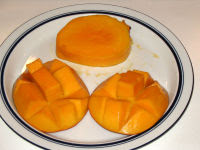 On first glance, a mango seems like it would be pretty simple to cut, but don't be fooled. Avoiding the large, flat seed in the middle can be tricky, and the wrong approach can leave you with a big, juicy mess. Cutting a mango in a "hedgehog" pattern can make for a neat, beautiful way to enjoy this tropical fruit.
On first glance, a mango seems like it would be pretty simple to cut, but don't be fooled. Avoiding the large, flat seed in the middle can be tricky, and the wrong approach can leave you with a big, juicy mess. Cutting a mango in a "hedgehog" pattern can make for a neat, beautiful way to enjoy this tropical fruit.
- Wash the mango. Do not peel the skin.
- Cut the mango into three pieces.
- A mango has a flat seed in the middle, and the fruit itself has the shape of a slightly flattened oval. Find the long axis of the mango.
- Make two parallel slices along the length of the flatter sides of the mango, on either side of the seed (assume the seed is 3/4" thick). You want a good amount of mango to be left on the cheeks.

- A mango has a flat seed in the middle, and the fruit itself has the shape of a slightly flattened oval. Find the long axis of the mango.
- Make light cross-cut slices on the two cheeks. Do not slice through the skin.
- With your middle and ring fingers, push the skin-side of the mango cheek up so that the skin can lie flat on the plate and your cross-cut fans out.
- Serve the mango as is, or cut along the base of the cross-cuts (close to the skin) and serve the pieces in a bowl. A curved, serrated "grapefruit" knife is very handy for cutting down close to the bottom curve of the skin from the cut edges.
- Eat the flesh around seed (if desired), by peeling off the skin from the middle section. Stick a fork in the middle of the seed (just slightly "hammer" it in with the palm of your hand), then chew around the seed to eat it. Beware the juicy mess!

Alternate Methods
1) Hold the Mango with the Stem joint UP. (That is vertically up.) Then slice it from the middle cutting around the middle seed. Now you have sort of two halves joined by the seed. Rotate the halves. One half will be set free from the other. Open it up and you have a bowl of mango fruit sans the seed. Now comes the difficult part. The other half still has the seed inside and popping out from it. Hold the seed with your teeth! and rotate the bottom half to free it from the seed. (This requires some practice and could be messy in the beginning). Now you have two bowl shaped halves without the seed. Freeze and eat with a spoon.
2) This method is less messy. Instead of cutting straight down the middle of the mango, begin to cut down through the middle of the mango, but then angle over to one side; as you reach the seed, begin to cut back around toward the middle (i.e., around the seed), then through to the other side. After you separate the halves, take a large spoon (preferably with a thin edge) and use it to scoop and cut around the seed, freeing the seed from that half.
3) If you are confident with a chef's knife, there is yet another way to remove the seed, similar to that used for avocados, which requires a bit of finesse and is somewhat dangerous for the unskilled. Do NOT attempt this unless you have a LOT of experience with kitchen knives;
When you have the two halves separated, as above, take the half with the seed and hold it in your off hand, with the seed facing up. Take the chef's knife, and strike the edge firmly and briskly against the seed, allowing it to become stuck. Then just rotate the knife, holding firmly onto the mango section, to free the seed. This can take some practice, even for the experienced cook, but looks more professional, and is MUCH faster than any other method of removing the seed.
4) Eat a mango without a knife! You need a fresh fully mature mango. Put the mango in your hand and squeeze it between the hands. You make the pulp sort of a liquid after a lot of squeezing open a hole on the tip with your teeth and suck all the pulp softened by the grip of your hand. (See also method below used in India)
Tips
- This is one way to cut a mango, but there are several other different methods that are worth trying:
- Some people find it easier to peel the skin, then simply cut slender slices from the flesh until the seed is completely exposed.
- In India, cutting a mango typically involves making a hole at the tip. First, wash the mango, then sort of squash it with your fingers, till you feel the meat inside become more of a liquid. Then cut a hole at the top from which the mango can come out. Although it may seem very messy, this is a very efficient and clean method with which to cut and eat mangoes.
- If you're feeling particularly ambitious, you may want to attempt to cut "mango on a stick."
- Hold the mango upright, and make a cut all the way around the circumference, about half way up the mango. Take hold of each end and twist in opposite directions. One end will become looser and if you rotate that, you can eventually slip it off. The other half now has the juicy pit sticking out of it. You have the skin-covered half to use as a handle, so you can suck half the pit clean. Then hold the end of the pit that you've cleaned up and do the twisting motion again until the second half of the mango comes away. You now have a clean end of the pit to hold onto, while you finish up the juicy other end. After that, you can use any of the other suggestions for how to cut/serve/eat the rest of the mango. It's just a shame to miss out on any of the pit!
- Some people find it easier to peel the skin, then simply cut slender slices from the flesh until the seed is completely exposed.
- Make sure the mango is ripe. It should not be too firm; press the mango lightly and see if it springs back and gives off a good scent. If it's too soft, it'll be stringy inside and not enjoyable.
- Fresh mango slices are yummy when sprinkled with lime juice and paprika.
- Floss after eating the mango, as the fibers can sometimes get stuck in your teeth.
Warnings
- The flesh can be very slippery. Be careful not to cut yourself in the process of cutting the zig-zag lines or peeling the mango itself.
- In my opinion, the flesh nearest the pit is also the stringiest and least pleasant to eat.
- If you can't stand sticky fruit juice running down your chin, you should definitely cut the mango into small pieces without the skin.
- If you are allergic to latex, poison ivy, or cashews you may have a reaction to mango, too, through cross-reactivity. Many people report an allergy only when contacting the skin of the mango. To prevent this, wash your hands with soap after peeling the mango but before eating it. For more information, search the Internet with the key words "mango" and "allergic."
- Mango juice will leave messy stains on clothes and all kinds of fabrics. These stains are persistent and almost impossible to wash out.

 How to Cut a Mango
How to Cut a Mango















0 comments :
Post a Comment